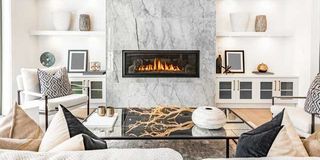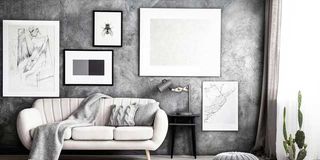Premium
5 Home styling rules you should never, ever break

There are really no hard and fast rules when it comes to home styling, you know this already. There are guiding principles, though, and these principles will help you style your home like a professional. They will help you achieve balance and alignment, proportion, contrast and emphasis and flowing movement.
What you need to know:
- There are really no hard and fast rules when it comes to home styling, you know this already.
- There are guiding principles, though, and these principles will help you style your home like a professional. They will help you achieve balance and alignment, proportion, contrast and emphasis and flowing movement.
- What’s more, you want to flex these principles to reflect your personality and enhance the experience of the people living in your home.
There are really no hard and fast rules when it comes to home styling, you know this already.
There are guiding principles, though, and these principles will help you style your home like a professional. They will help you achieve balance and alignment, proportion, contrast and emphasis and flowing movement.
What’s more, you want to flex these principles to reflect your personality and enhance the experience of the people living in your home. You style for them and style for yourself, too. You can only flex the guiding principles after you have mastered them through trial and error.
While these guiding principles are fluid, there are some rules that should not be broken. Consider them as styling faux pas that you should stay clear of because they will dilute the hard work of your styling and make your space appear out of balance and alignment, out of proportion, off-contrast and overemphasis and without a flowing movement.
Here are five of those rules:
Curtains that are too short
Having short curtains is a definite no-no for your home. Short curtains don’t reach the floor. If they are kitchen curtains, they are purposefully short, yes, but they are much closer to the curtain box/rod than they are to the window sill.
The ideal length of curtains is those that fall from the curtain box/rod all the way down to the floor. They are not puddled on the floor either (because that would make them too long) – they are ‘kissing’ the floor with just the slightest of touch.

Having short curtains is a definite no-no for your home. Short curtains don’t reach the floor. If they are kitchen curtains, they are purposefully short, yes, but they are much closer to the curtain box/rod than they are to the window sill.
The best way to get the ideal length for your curtains is to measure the height from the floor to your curtain box/rod. Not all homes have a standard height. Also add extra inches for hems, eyelets, hooks and runners.
Most importantly, get a professional to cut and stitch them for you. Curtains are too expensive to make amateur mistakes with.
Rugs that are too small
You will know that your rug is too small for your space when it appears to float about in the middle of your space. If it’s the living room rug, the only piece of furniture on it is your coffee table. Everything else is noticeably inches away from it. If it’s the dining room rug, most of the dining room chairs cannot sit on it. Perhaps not even the dining table is fully on it.
If it’s the bedroom rug, then the bottom legs of your bed are not sitting on it.
Buy rugs guided by the space in your home. At the very least, the two front legs of your living room furniture should all be sitting on the rug. For the dining room, all four legs of the dining room chairs should be on it. For the bedroom, the legs… well, you catch my drift already.

You will know that your rug is too small for your space when it appears to float about in the middle of your space. If it’s the living room rug, the only piece of furniture on it is your coffee table. Everything else is noticeably inches away from it.
Another guiding principle is to have a rug that’s about eight to 24 inches away from the wall. Seeing some bare floor between the wall and the rug also creates the illusion of more space than you have.
Overmatching your sets
Another styling rule not to break in this modern era is to not overmatch your sets.
You know you are overmatching your sets when your sofa set – the main couch and two armchairs, maybe three – are crafted in exactly the same fabric and style. You could also go on to upholster your dining room chairs in the same fabric.
Perhaps even your curtains will borrow a bit from this fabric. A better way to do it is to have your main couch match – perhaps – to one armchair, the other armchair is an accent chair. Accent chairs are a far different style from the other chairs.
To tie in your sets together, you can use the same colour in different tones (a maximum of three tones). Or contrasting colours that complement one another. Let the elements borrow from one another.
Covering your fireplace
If you happen to have a home that has a real brick-and-cement fireplace, then the styling rule is not to cover it up. It doesn’t matter if you use it or not, don’t cover it up with anything. A fireplace is a beautiful architectural detail that adds a lot of charm to your home. And it presents a fantastic styling opportunity for you.

If you happen to have a home that has a real brick-and-cement fireplace, then the styling rule is not to cover it up. It doesn’t matter if you use it or not, don’t cover it up with anything.
Use it as a focal point for your living room. Use the mantel to tastefully display your accessories while the wall above it can be a mounting canvas for your TV or any framed photos, artwork or mirror.
Hanging your artwork too low or too high
Hanging up artwork requires a tape measure, masking tape, a spirit level and a lot of patience. You need the tape measure to measure the distance from the floor to the middle of the artwork, and where to hang the artwork. The ideal distance is 57 inches, this is the eye level for most people. You can go a few inches up or down, but don’t veer off too much from these 57 inches.

Hanging up artwork requires a tape measure, masking tape, a spirit level and a lot of patience. You need the tape measure to measure the distance from the floor to the middle of the artwork, and where to hang the artwork.
Use your masking tape to run the length of the wall from 57 inches from end to end. Make sure it’s a straight line. Any piece of artwork you intend to hang should use this line as its reference point.
Once it is hung and hooked, use your spirit level to check that it’s centred properly.
[email protected]; @_craftit





